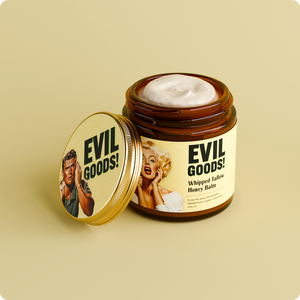Beef tallow has been around for a long time, and people use it for different things. You’ll find it in frying pans, skincare routines, and soap recipes, thanks to its rich flavor and moisturizing properties. But one question keeps coming up for tallow users: How long does beef tallow last?
This article breaks it down: how long it lasts, how to store it, and when it’s time to toss it.
Understanding Beef Tallow
Beef tallow comes from rendered beef fat, taken from the kidney or suet area of a cow. The fat is purified, strained, and turned into a creamy, shelf-stable substance packed with nutrients to use on your skin. This process removes impurities and moisture, resulting in a product that is similar to a thick balm or cream.
People have used tallow for centuries, for cooking, and as a base for candles, balms, and traditional remedies. Today, many people use it for the same reasons our ancestors loved to use it. It's clean, natural, and packed with benefits.
Tallow is also rich in saturated fats. It can sit at room temperature for months without going bad. It contains linoleic acid (a naturally occurring trans fat that supports metabolic health), omega-3 fatty acids, and fat-soluble vitamins like vitamin A, D, E, and K.
In the kitchen, tallow delivers a rich flavor and a high burning point that’s great for searing, roasting, and deep frying. In skincare, it's similar to our skin sebum, which is an effective moisturizer. You'll find it used in everything from facial creams and healing salves to pie crusts, soap making, and baked goods.

How Long Does Beef Tallow Last?
Beef tallow has a long shelf life. This is one of the reasons it's so popular in kitchens and skincare routines. When you store it at room temperature, it can last up to a year. When you refrigerate or freeze it, you can extend that life to two years or more.
The quality and purity of the tallow are also important, regardless of where you keep it. If you render it well, strain out all impurities, and use sterilized containers, your fresh homemade beef tallow will last longer. Tallow made from grass-fed cow fat tends to last longer because of its cleaner composition and higher nutrient density.
If you expose tallow to food particles or in warm places, it may spoil faster. If you use beef tallow often, consider storing a batch at room temperature and the rest in the fridge or freezer to keep it fresh over time.
Tallow's shelf life makes it a great ingredient. The better you store it, the longer you can enjoy it
The Rendering Process of Beef Tallow
Rendering beef tallow means separating the fat from moisture and impurities by melting it. There are two kinds of rendering processes:
Dry Rendering
Dry rendering involves warming chopped beef on a low heat, in a heavy-bottomed pot or skillet, without adding water. As the fat melts, it separates from the tissue and meat. Stir to prevent sticking or burning.
Once melted, pour the liquid fat through a mesh strainer or cheesecloth to remove solids. Let it cool down before transferring it into containers for storage. This method produces a tallow that’s perfect for your skin.
Wet Rendering
Wet rendering, used in commercial settings, involves steaming the fat in water. The water stops the fat from scorching and makes it easy to control the temperature. As the mixture heats up, the fat separates and floats to the surface. Once rendered, the liquid is cooled so the fat solidifies at the top, where you can scoop it off.
Wet rendering is effective for large batches; it takes longer and requires cleanup than dry rendering.

How Can You Store Beef Tallow?
Depending on how long you want it to last, you can store beef tallow in the following ways:
Room Temperature
You can store your beef tallow in a cool, dark place, like a pantry. Use glass jars, mason jars, or similar containers. This method is for short to medium-term storage, for a year.
Refrigeration
Good if you use tallow often. Cold storage helps it stay firm and fresh for over a year.
Freezer Storage
Freeze beef tallow in safe containers or vacuum-sealed bags. Label and date them to keep track of freshness.
Scoop the tallow using clean and dry utensils. This will help you avoid contamination. This habit can make a difference in how long your tallow lasts.
Why is it Important to Properly Store Beef Tallow?
You should store your tallow properly because:
- Exposure to air, heat, moisture, and light speeds up the oxidation process in beef tallow, causing rancidity and nutrient loss.
- Beef tallow that’s stored improperly can develop a foul smell, discoloration, or mold growth. This will affect the taste and compromise the nutritional value and moisturizing properties of your beef tallow.
- Bad tallow can cause breakouts or irritation when used on your skin.
Common Storage Mistakes You Can Avoid
Keep your tallow in good condition by avoiding these mistakes:
- Leaving it exposed to air.
- Leaving it in containers without tight lids.
- Letting water or moisture get in.
- Storing it close to smelly foods.
- Using dirty utensils to scoop tallow.
- Putting it under sunlight or a spot with temperature swings.
These mistakes might seem unimportant, but they’ll shorten your beef tallow’s lifespan.
How to Extend Beef Tallow’s Shelf Life
How you handle and store your tallow can affect how long your batch lasts and how fresh it stays. You need to think long-term to get the most out of your beef tallow. Extending its shelf life comes down to protecting it from the elements that cause spoilage – air, moisture, heat, and light.
-
Use containers like glass jars: Oxygen is beef tallow’s biggest enemy. When air gets in, spoilage begins, which leads to an unpleasant taste and smell. Use containers with tight-sealing lids. Glass is best because it doesn’t react with the fat. Divide larger batches into smaller mason jars or containers. This will limit how often you expose the entire supply to air and light. Keep one jar for daily use and store the rest in the fridge or freezer. This method ensures your beef tallow stays fresher and makes it easier to grab what you need.
-
Prevent contact with water or contamination: Any moisture that gets into your beef tallow can create an environment for bacteria to grow. Always use clean, dry utensils and avoid storing them where condensation could form.
-
Keep it in a dark place, away from direct sunlight: Light can increase the process of decay, especially where there is heat. Store the tallow in a pantry or cabinet that stays consistently cool and dark.
- Freeze beef tallow or store it in the fridge: For long-term storage, nothing beats the cold. Freeze beef tallow to prevent spoilage and reduce the aging process. You can use containers to store beef tallow. Rotate your supply using the first-in, first-out method. If you make or buy beef tallow regularly, label containers with dates and use older batches first to prevent them from sitting too long and going bad. Scoop out only what you need with a clean, dry utensil each time. This stops you from introducing bacteria and moisture that can cause it to spoil. Don't use your fingers or double-dipping tools.

What are the Factors that Affect Beef Tallow’s Shelf Life?
Rendering Quality
If you render the tallow over low heat and strain it properly, you’ll remove moisture and food particles that can cause bacterial growth and spoilage. Cooking on high heat can burn the fat or leave impurities that shorten its shelf life.
Storage Method
The containers you choose and the place you store them are important. Use containers such as glass jars to keep out air and moisture. They don’t absorb odors and will protect against exposure.
Room Temperature
Store your tallow in a place with a consistent temperature. Heat and moisture can cause condensation inside the container, which can lead to decay. Keep it in an environment like a pantry or basement.
Light Exposure and Oxygen
These speed up the oxidation process, which is the leading cause of rancid fat. Sunlight and oxygen break down the fat molecules, destroying tallow's nutritional value and giving it a foul odor. You can prevent this by storing beef tallow in dark places and always keeping lids tightly sealed. For better results, freeze beef tallow.

Is it Safe to Use Old Beef Tallow?
Yes, but you need to be cautious. Older tallow doesn't automatically mean bad tallow. When you store it properly, beef tallow can remain usable for a long time, beyond a year. Like any fat, beef tallow is prone to decay and contamination if you don’t handle it properly.
Before using old tallow, always perform a check:
- Smell it: A clean or faintly meaty scent is fine. If you notice a sharp, sour, or chemical-like odor, it has gone bad.
- Feel the texture: Proper tallow should be smooth. If it has separated, appears gritty or lumpy, has turned red, or has developed a sticky film, it's best to toss it out.
- Inspect for mold: Any visible mold growth or discoloration, especially around the edges or lid, means it's time to throw it out.
Spoiled beef tallow is not safe for cooking or skin care. If you use it to cook, you introduce harmful substances to your meals, and if you apply it to your skin, it may cause breakouts, rashes, or irritation.
When in doubt, it’s better to stay on the side of caution. Throw out questionable tallow and start fresh.
When Should You Throw Out Beef Tallow?
Even the best-stored beef tallow doesn't last forever. Knowing when to throw it out is necessary for protecting your skin and food. And like we mentioned earlier in this article, here’s how you know:
- If it smells like sour oil, spoiled meat, or something bad.
- If it has mold, becomes slimy, or forms clumps and discoloration.
- If it has been contaminated.
- If it has absorbed odors from garlic, onions, or spices stored nearby. While it may not be spoiled, it might not be safe for skincare.
Consider how it was handled over time. If you’ve used dirty utensils, exposed it to moisture, or stored it in changing temperatures, then the tallow might not be safe (even if it looks okay). When in doubt, trust your senses or start a fresh batch.
FAQs About Beef Tallow
Does Beef Tallow Go Bad?
Yes, beef tallow goes bad. When this happens, it may smell bad, change texture, and have mold growth in it. You can stop this by storing tallow in containers and keeping it in a dark and cool place.
How Do I Tell if My Beef Tallow is Bad?
Check the smell, texture, and appearance. Spoiled beef tallow usually smells sour, has discoloration, or feels sticky. A mild scent and smooth texture are signs that your tallow is good to use.
How Does Beef Tallow Smell When It's Bad?
Bad tallow smells like old cooking oil, spoiled meat, or something sour. If you’re not sure, it’s best to discard it. Spoiled tallow loses its properties and can irritate the skin or ruin recipes.
Does Beef Tallow Need to be Refrigerated?
Tallow can stay on the shelf due to its saturated fat content, and it can stay fresh at room temperature for several months. However, refrigeration or freezing helps extend its shelf life, especially if you don’t use it regularly or you’ve made a large batch.
Final Thoughts on Beef Tallow Storage
How long does beef tallow last? When you follow good storage tips, you can enjoy your homemade beef tallow for up to a year or longer. The way you store it influences its shelf life and benefits.
If you want to make the most of your batch, follow the advice in this guide and treat your tallow like the nutrient-rich, multipurpose fat it truly is. If you’re looking for the best beef tallow for skincare, check out our beef tallow skin products, designed to nourish and protect your skin.

Dr. Elena Dinkollari
MD, Dermatologist & Endocrinology Assistant
Doctor Approved








